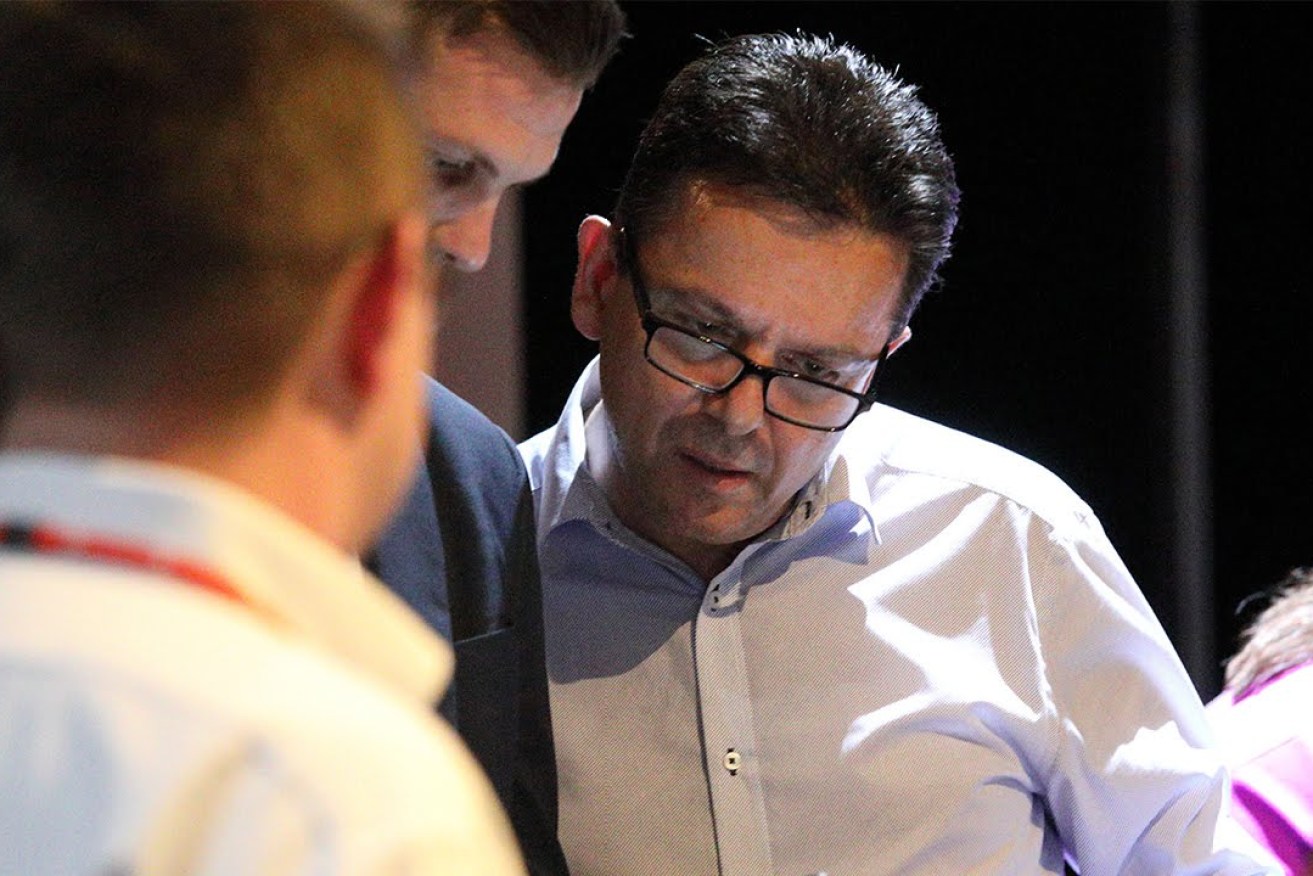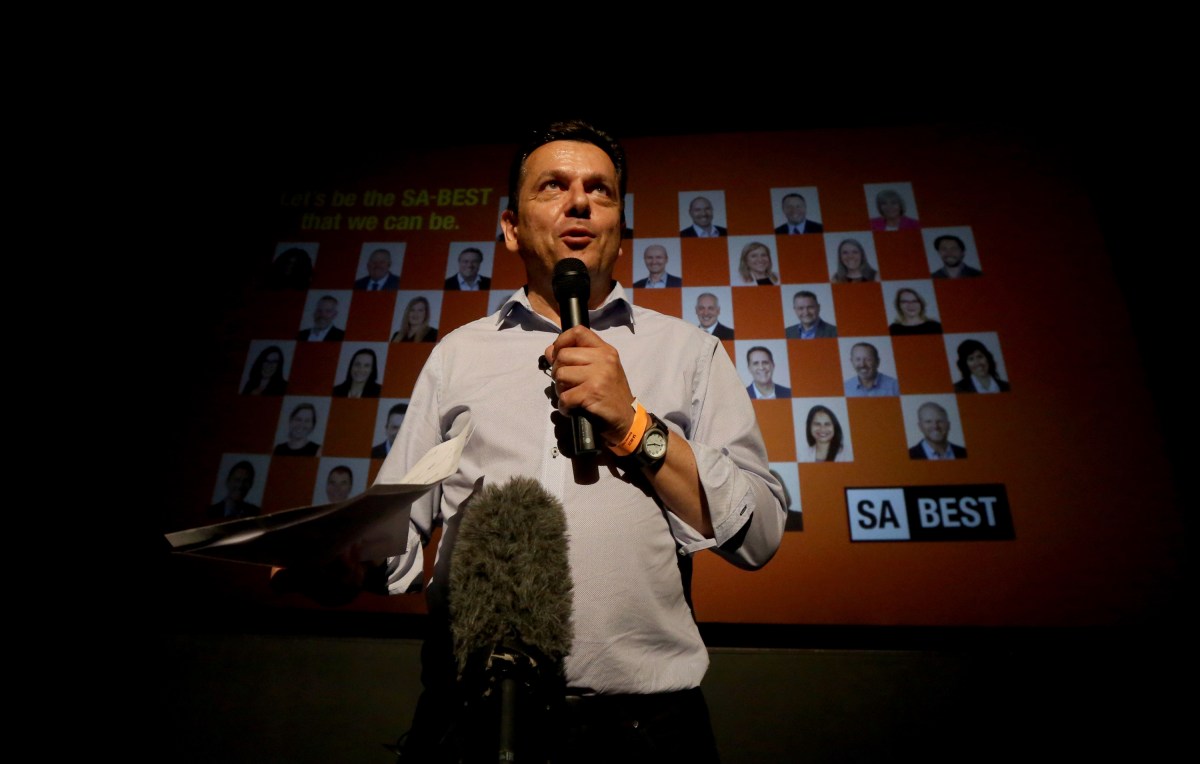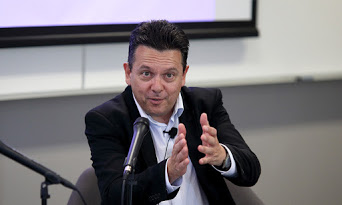Why the SA Best bubble burst: a quasi-insider’s account
Political scientist Haydon Manning ceased commentary on the state election due to his close family ties to Nick Xenophon’s SA Best. However, in the first of a two-part series, he now provides a warts-and-all analysis of what went wrong in the campaign – the lack of funding and seasoned campaigners, and the strategic mistakes from the man who insisted on running the show almost single-handedly.

Nick Xenophon watches the bad news roll in on election night. Photo: Tony Lewis/InDaily
It takes a prominent politician to launch a new party to effectively challenge the ‘duopoly’ of Liberal and Labor. It happens rarely and is normally focussed on upper houses.
In 1977, a few months after Don Chipp resigned from the Fraser Government ministry, he formed a centrist party, the Australian Democrats. The Democrats prospered, electorally speaking, for 25 years with the party’s strongest representation found mainly in SA. Pauline Hanson’s One Nation at the 1998 Queensland State election is the only contemporary example of a new party breaking through to win single-member electoral contests. That breakthrough lasted for only one election.
When Nick Xenophon resigned from the Senate to lead his startup party, SA Best, there was every reason to believe it may emulate these ventures and early opinion polls suggested that a significant political breakthrough was in prospect.
For the past four months, I gained a quasi-insider’s insight into SA Best’s campaign due to my wife, Hazel Wainwright, running for the party in Mawson. I ceased all public commentary and kept a journal. I ‘break the ice’ here with some observations regarding why the Xenophon venture failed and seems unlikely to pose any future threat to the state’s two-party system.
With two state and three federal MPs, the party is not yet dead and may be in a position to maintain a modest upper house presence – in the SA Legislative Council and representing SA in the Senate. However, its hopes of a lower house representation in state parliament appear quite broken.
I’ve taught politics at Flinders University for three decades and over the past two decades regularly commented on state and national political events. Professionally, I gained an invaluable insight not only into the machinations of SA Best’s campaign but also the savvy ruthlessness of the major parties out in the “battlefield” electorate that was Mawson.
Media tactics always tended to trump strategic thinking.
Perhaps most significantly, I gained a unique insight into the emotional side of an election campaign, notably the unremitting anxiety and unpredictability of it.
I now appreciate the raw courage it takes for candidates to put their faces on those endless campaign banners, to stand outside shopping malls, to door knock, to debate at public forums and to endlessly post and respond to Facebook and emails. To all candidates, of all parties, I salute your individual commitment to political ideals, self-sacrifice and hard work.
I am not an SA Best Party member, however, given my political knowledge, Nick Xenophon occasionally rang me. I offered basic electoral matters advice to campaign director Connie Bonaros, addressed SA candidates on what to expect and, most significantly, was in touch frequently with one of Xenophon’s key non-parliamentary advisers, a former colleague from Flinders University who has spent some 25 years involved in politics, government and media.
I am confident I have a sound sense of went wrong for SA Best and invite others to dispute my assessment.
Appetite for change
When SA Best was launched in March 2017 I surmised that SA voters shared, like others around the democratic world, a nascent desire to “experiment” by voting for something different. A high level of disenchantment with both Labor and Liberal was evident but it was unclear whether this would drive a major realignment of the long-entrenched political system.
Nick Xenophon’s dramatic decision to resign from the Senate and contest the lower house state seat of Hartley unquestionably shocked Liberal and Labor in the countdown to the state election campaign. Whatever Xenophon’s precise thinking was in deciding to run in Hartley, in contrast to heading the SA Best Legislative Council ticket, it was a high-risk strategy. Xenophon declared that SA politics were “broken” and that he would campaign to win lower house seats with the aim of securing the balance of power to push an agenda focussed on parliamentary reform and improved government accountability and transparency.

Nick Xenophon after announcing his decision to run for state parliament in October last year. Photo: AAP/David Mariuz
The question was, could Xenophon weld a new party around a carefully crafted campaign with modest objectives? Could he find carefully selected candidates pitched at winnable seats carrying a message that Xenophon was associated with – namely that prudent application of balance of power politics and the populist “keeping the bastards honest” ethos?
The prospects appeared inviting, with the Weatherill Government set to go down in a screaming heap akin to other long-serving state Labor governments. During the past year, the baggage of high electricity prices and the Oakden and the TAFE debacles plus the “it’s time” factor suggested many Labor candidates would fall behind SA Best candidates on the primary vote. One could readily anticipate negative swings across the board, of around 10 per cent, akin to what happened to many Labor MPs at the 2010 state election.
For the Liberals, the Opposition leader continued to lag on the preferred Premier stakes and in the course of many discussions, I never found a Liberal Party member, let alone a voter, offering much praise for Steven Marshall. Such is the lot of being a state Opposition leader, where lacking recognition or authority tends to be the norm. As a consequence, we saw the Liberals produce a major campaign video to tell voters who Marshall was.
I’ve been told that many Liberal MPs were despondent when reading the pre-Christmas Newspoll numbers: arguably, that forged the ferocity of the Liberal Party’s ultimately very effective attack on SA Best. Marshall’s refusal to deal with Xenophon post-election and his claim of a secret deal between Weatherill and Xenophon reflected the sort campaign toughness the SA Liberals had shunned in the past.
Before both major parties turned their negative campaigning prowess toward SA Best, it did it seemed that the duopoly was in serious trouble. They were ripe to bleed primary votes to SA Best, led as it was by one of the state’s most trusted politicians.
Over the past six years the Xenophon political brand, in its various incarnations, managed election day voter support in the low 20 per cent range, and Rebekha Sharkie managed to win Mayo with a 35 per cent primary vote.
Leading into the New Year and the first weeks of January a series of opinion polls suggested that, with a remarkable surge in state-wide support towards the high 20s and even into the low 30s, SA Best would win a bagful of seats. But this support proved to be short-lived. By early February polls appeared pointing to voters reaching a very different verdict. If support surged for SA Best in December and early January, it had equally quickly deflated by the first week of February.
Something had happened with SA Best’s fledgling brand. The question is, what caused such a reversal, and in such a short space of time?

Manning says Nick Xenophon was focused on media tactics, rather than broader strategy. Photo: AAP/David Mariuz
The following factors are, arguably, among the key planks required to mount a successful election campaign that might manage to challenge the duopoly. Given that SA Best was launched in March 2017 and first mooted shortly after the July 2016 national election, there was time to get much of the following in place.
First, financing the campaign needed to be well planned and secured with significant donors committed. Crowdfunding should be an option following recent campaign experiences in the UK and the USA.
Second, six to a maximum of 10 candidates should be preselected for winnable seats and ready to commence door knocking in early Spring. With fewer candidates, the leader could lend support, and on occasions, media attention to their campaigning.
Third, a campaign director or an effective team with past campaign experience should be appointed to start work at least four months from polling day. And, significantly this individual, or team, set a strategy that would frame the campaign tactics whereby a consistent and relentless narrative would unfold.
Fourth, consistent with seeking a balance of power position rather than a place in government, detailed policy should be restricted to about half a dozen key areas.
Fifth, in the case of SA Best, the party leader needed to move beyond the showman/stuntman persona and strive for a more earnest statesman demeanour.
The question of funds
While eyebrows were raised when it was reported that SA Best candidates staked $20,000 to party coffers I saw this a prudent check on the pre-selection process because it ensured the vetting process would not be overwhelmed with applications. Moreover, sitting MPs fundraise and I’m reliably informed something in the order of $60,000 is required to mount a respectable state marginal seat campaign.
Securing major donors was a prerequisite for an all-round campaign but I learned later – much later – that promises of donations did not meet expectations. Unlike Labor with the unions and the Liberals with business, SA Best lacked a large constituency willing and able to provide financial support. Over 20 years Xenophon had run modest campaigns, largely relying on free media publicity rather than paid advertising, direct mail, robo-calls and on-the-ground organisation. A state-wide campaign contesting lower house seats requires a much more substantial financial base. However, a significant number of potential business donors backed away, claiming that they feared retaliation against their interests by whichever side, Liberal or Labor, eventually formed government.
Xenophon took out a personal loan of $600,000, mortgaging his own apartment, and this worried him – a lot. That may partly explain the expansion of candidate numbers way beyond the original objective, given that new public funding law promised about $3 per vote.
How many candidates?
In the beginning, the candidate vetting process was very thorough and followed major party practice whereby prospective candidates pitched to sub-branches, branch members voted and those selected were interviewed by Xenophon’s “campaign team” and also asked to complete psychometric tests. Thus, the initial selection process took considerable time, relatively few candidates made the grade and announcement dates were repeatedly put off. This had the unintended consequence that the few candidates who were selected early were unable to start campaigning on the ground until late in 2017. Six months earlier would obviously have been preferable.

Xenophon on election night in front of a poster of his SA Best candidates. Photo: AAP/Kelly Barnes
As to the key question of how many candidates SA Best would run, The Advertiser [17 September] reported that 12 was the ‘magic number’ and quoted Xenophon saying: “I think it is realistic, but we’re in it to win. We’d rather run fewer candidates with the aim that we know we’ll have a chance of winning.”
In early October, six candidates were announced with the promise of another six soon. However, it was a struggle to find the next batch and this was a sobering lesson for a startup party, and one the Liberals have also struggled with – namely, it is not that attractive to run for office. In late December, the second group was announced and one figured it would end there. However, that was not to be the case.
Where are the campaign professionals?
I’ve read books, most recently Michael Ignatieff’s insightful Fire to Ashes: Success and Failure in Politics, and lectured on what it takes to run a modern campaign. I’ve invited Liberal and Labor campaign directors to lecture and I’ve taught many students who work on campaigns. One gains a sense of the magnitude of the task, the darker arts required and the simple need to see the leader work as part of a team that advises on strategy and tactics.
Given Xenophon’s 20 years as an MP, it was reasonable to assume his network of contacts would render an experienced campaign director willing to put aside his or her major party allegiances to run the campaign for the highly prospective SA Best outfit.
No such persons were available and the task of director fell to Connie Bonaros, who had never conducted a campaign. In fairness to Connie, she rose to the occasion and managed to orchestrate a campaign on the basis of very limited resources – both financial and human. However, Connie’s role proved to be largely administrative with overall “strategy”, or rather “tactics”, solely in the hands of Xenophon.
How much policy is enough?
What’s in a name is a question worth asking about the title, SA Best.
From the outset, I thought the name was odd but concluded that perhaps a kernel of logic could be found as means for handling the inevitable question: “Where are your policies and costings?” The leader and candidates could argue: “We have our own key policies and if elected to the balance of power, that is what we will insist upon – among other factors – in determining who to back into government.”
Beyond the key SA Best policies, it seemed to me legitimate to play on the “best” dimension to argue that the best elements of major party policies, beyond the core SA Best policies, would inform SA Best’s deliberation in light of the party’s principles.
Perhaps I’m naïve thinking that was possible but, frankly, it was always too much to expect a party with scant resources to have a plethora of detailed policy positions. Rather, a focus on detail and costings was required for only a handful of obviously big ticket items such as, electricity pricing and the grid’s management, the health and education systems, reforming parliament and bureaucracy, and maybe one or two other areas.

Xenophon with Skye Kakoschke-Moore, when she announced her resignation from the Senate. Photo: AAP/David Mariuz
To my great consternation, in November it was reported that, rather than focus on developing policy and plotting the upcoming campaign, the leader was off working part-time for newly appointed NXT Senator, Rex Patrick. From mid-year in 2017, key policies should have been researched and developed and completed by year’s end with all candidates fully briefed on their contents.
Why that did not happen remains a puzzle. Perhaps successive events, especially the personal and political attack on Xenophon’s by his former girlfriend Jenny Low, the imbroglio over Tim Storer’s claim to fill Xenophon’s vacant Senate seat, and NXT Senator Skye Kakoschke-Moore’s resignation as a consequence of her newly discovered British citizenship, all greatly distracted Xenophon from policy and campaign preparation. Whatever the case, it is also apparent that he kept the policy agenda concentrated in his own hands and failed to progress it, to any significant degree, before the end of 2017, and indeed into early January 2017.
From about mid-January SA Best pumped out policies – far too many in my view. As a result, it was a complete fallacy to argue, as the major parties did, that SA Best “did not have policies”. Candidates and party HQ were bombarded with questions- “what’s your policy response?” – and too often a policy response was developed hurriedly, with inadequate preparation, when the focus should have been on advocating, relentlessly, a few key policies.
What it takes to lead
Xenophon is a brilliant retail politician, a man of high intelligence, great energy and tremendous dedication to take a brief if he thinks he can help an individual or organisation. He is unsurpassed as the champion of the underdog and that explains why he has been so highly regarded and trusted.

Xenophon’s key weakness, according to Manning, was his failure to take advice from others. Photo: Tony Lewis/InDaily
His Achilles heel, it appears, lies with his reluctance to take advice from a group – a campaign committee, for example – preferring instead to be counselled by a few trusted individuals. He also struggles to delegate and is prone to micro-management and consequent paralysis when overwhelmed by competing demands on his time and energy. Such a disposition may suit well the role of independent Senator, but it is ill-suited to leading a party and addressing effectively the multitude of challenges an election campaign presents.
Xenophon appears driven by a constant need to find a tactical advantage that he alone determines and tends to hurriedly run past one individual but never a committee of advisers. Often he would agree to a course of action, but then fail to follow through, more often than not preoccupied with the next radio interview or media event. Media tactics always tended to trump strategic thinking.
Determining a central political narrative requires many minds, and hopefully some experienced ones, and then requires real focus to keep on track amidst the inevitable alarms and excursions of a political campaign.
Alas, Xenophon could never achieve the necessary discipline or focus and that explains, in large part, why SA Best so rapidly lost voter confidence.
Haydon Manning teaches politics in the College of Business, Government and Law at Flinders University. As noted above, his wife, Hazel Wainwright, was SA Best’s candidate for Mawson.
Part 2 of Manning’s analysis will be published in InDaily tomorrow.




